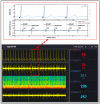Tablet-Based Wearable Patch Sensor Design for Continuous Cardiovascular System Monitoring in Postoperative Settings
- PMID: 37366980
- PMCID: PMC10296635
- DOI: 10.3390/bios13060615
Tablet-Based Wearable Patch Sensor Design for Continuous Cardiovascular System Monitoring in Postoperative Settings
Abstract
Meticulous monitoring for cardiovascular systems is important for postoperative patients in postanesthesia or the intensive care unit. The continuous auscultation of heart and lung sounds can provide a valuable information for patient safety. Although numerous research projects have proposed the design of continuous cardiopulmonary monitoring devices, they primarily focused on the auscultation of heart and lung sounds and mostly served as screening tools. However, there is a lack of devices that could continuously display and monitor the derived cardiopulmonary parameters. This study presents a novel approach to address this need by proposing a bedside monitoring system that utilizes a lightweight and wearable patch sensor for continuous cardiovascular system monitoring. The heart and lung sounds were collected using a chest stethoscope and microphones, and a developed adaptive noise cancellation algorithm was implemented to remove the background noise corrupted with those sounds. Additionally, a short-distance ECG signal was acquired using electrodes and a high precision analog front end. A high-speed processing microcontroller was used to allow real-time data acquisition, processing, and display. A dedicated tablet-based software was developed to display the acquired signal waveforms and the processed cardiovascular parameters. A significant contribution of this work is the seamless integration of continuous auscultation and ECG signal acquisition, thereby enabling the real-time monitoring of cardiovascular parameters. The wearability and lightweight design of the system were achieved through the use of rigid-flex PCBs, which ensured patient comfort and ease of use. The system provides a high-quality signal acquisition and real-time monitoring of the cardiovascular parameters, thus proving its potential as a health monitoring tool.
Keywords: analog front end (AFE); cardiovascular health monitoring; electrocardiography (ECG); heart and lung sounds; patch sensor; stethoscope; tablet-based software.
Conflict of interest statement
The authors declare no conflict of interest regarding the publication of this paper.
Figures














Similar articles
-
[Implementation of Wearable Wireless Chest Patch Monitoring Terminal].Zhongguo Yi Liao Qi Xie Za Zhi. 2024 Sep 30;48(5):561-567. doi: 10.12455/j.issn.1671-7104.230581. Zhongguo Yi Liao Qi Xie Za Zhi. 2024. PMID: 39463090 Chinese.
-
Heart and Lung Sound Measurement Using an Esophageal Stethoscope with Adaptive Noise Cancellation.Sensors (Basel). 2021 Oct 12;21(20):6757. doi: 10.3390/s21206757. Sensors (Basel). 2021. PMID: 34695968 Free PMC article.
-
A Wearable Multimodal Wireless Sensing System for Respiratory Monitoring and Analysis.Sensors (Basel). 2023 Jul 29;23(15):6790. doi: 10.3390/s23156790. Sensors (Basel). 2023. PMID: 37571572 Free PMC article.
-
MEMS and ECM Sensor Technologies for Cardiorespiratory Sound Monitoring-A Comprehensive Review.Sensors (Basel). 2024 Oct 31;24(21):7036. doi: 10.3390/s24217036. Sensors (Basel). 2024. PMID: 39517931 Free PMC article. Review.
-
Noncontact Wearable Wireless ECG Systems for Long-Term Monitoring.IEEE Rev Biomed Eng. 2018;11:306-321. doi: 10.1109/RBME.2018.2840336. Epub 2018 May 29. IEEE Rev Biomed Eng. 2018. PMID: 29993585 Review.
References
-
- Liddle C. Principles of monitoring postoperative patients. Nurs. Times. 2013;109:24–26. - PubMed
-
- Dabbagh A. Cardiovascular Monitoring in Postoperative Care of Adult Cardiac Surgical Patients. In: Dabbagh A., Esmailian F., Aranki S., editors. Postoperative Critical Care for Adult Cardiac Surgical Patients. Springer International Publishing; Cham, Switzerland: 2018. pp. 143–204.
MeSH terms
Grants and funding
LinkOut - more resources
Full Text Sources

